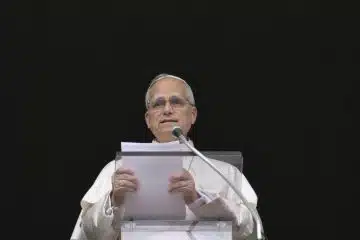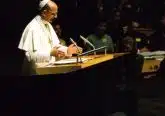Seize the Moment for October: Pope revises catechism teaching on death penalty
 The Catechism reads a little differently now as of Aug. 1. The pope revised paragraph 2267 on capital punishment to read as follows:
The Catechism reads a little differently now as of Aug. 1. The pope revised paragraph 2267 on capital punishment to read as follows:
Recourse to the death penalty on the part of legitimate authority, following a fair trial, was long considered an appropriate response to the gravity of certain crimes and an acceptable, albeit extreme, means of safeguarding the common good. Today, however, there is an increasing awareness that the dignity of the person is not lost even after the commission of very serious crimes. In addition, a new understanding has emerged of the significance of penal sanctions imposed by the state. Lastly, more effective systems of detention have been developed, which ensure the due protection of citizens but, at the same time, do not definitively deprive the guilty of the possibility of redemption. Consequently, the Church teaches, in the light of the Gospel, that “the death penalty is inadmissible because it is an attack on the inviolability and dignity of the person” (Francis, Address, Oct. 11, 2017), and she works with determination for its abolition worldwide.
When I first read this, I was shocked. Inadmissible? How is this not a complete change to what the church had previously taught?
A closer examination is important for us to understand what the pope has done here because the church’s stance on capital punishment affects our witness to the world. It’s our answer to the question, “How dedicated are you really to the dignity of the human person?”
The original wording of paragraph 2267 frequently left people of good will debating when capital punishment could be used. It acknowledged that “the traditional teaching of the church does not exclude recourse to the death penalty,” and it observed that the cases in which it is absolutely necessary to execute the offender “are very rare, if not practically nonexistent.” Some proponents of capital punishment would read this and say, “See? It’s not always wrong, just sometimes.” The church had given them an inch, and it was tempting to take a mile.
The original wording also included an important statement that was often lost in the debate on capital punishment. It read: “If, however, non-lethal means are sufficient to defend and protect people’s safety from the aggressor, authority will limit itself to such means.” An important question remained: At what point do we finally say that our non-lethal means are sufficient?
In the new wording, Pope Francis declares that capital punishment is inadmissible only after surveying the state of our understanding of human dignity and our current systems of detention. He has determined that non-lethal means are now sufficient to defend and protect. Therefore, we will limit ourselves to such means and consider the
death penalty inadmissible.
Note that the new wording does not say that capital punishment is intrinsically evil (as in, evil always and everywhere, like abortion or euthanasia). In this sense, the teaching of the church has not changed. Instead, it simply says that, in light of current circumstances, it is no longer necessary. Basically, he has shifted the conversation from, “When can we kill someone?” to “What can we do to defend and protect society without resorting to this?”
Pope Paul VI challenged the world in a similar way in 1968. His advisors were telling him to make contraception permissible, at least in certain situations. Instead, he wrote “Humanae Vitae,” which courageously taught that contraception was contrary to human dignity, and he challenged the church to come up with creative solutions to the problem of spacing births while maintaining unity and fruitfulness. As a result, Natural Family Planning was born.
What will be the creative solution to the problem of capital punishment? We’ll have to wait and see. In the meantime, let’s seize upon this exciting time to be Catholic, and let’s radically commit ourselves to the dignity of every human person.













